Connections between Water, Energy and Landscape: The Social Acceptance in the Monachil River Valley (South of Spain)
Abstract
:1. Introduction
2. Background
3. Material and Methods
3.1. Study Area
3.2. Material and Methods
- The general presentation of the interviewee (his or her life, work, hobbies, problems, challenges, and initiatives in the valley).
- Dynamics, evolution of the territory and main resources.
- The relationship with the landscape.
- The landscapes of the future.
- Energy (renewable energies, renewable energy projects, relations with other economic activities in the locality, local articulation of the exploitation of resources, energy transition, factors that have led to the projects, and obstacles to their implementation).
- Networks and social groups.
- Relationship to place.
- Households and energy habits.
- Energy transition.
- Local renewable and competition for resources.
- Sustainability of renewable energy.
- Energy landscapes.
4. Discussion and Results
4.1. Renewable Energy in Monachil: Hydroelectric Energy
4.2. Identity Values and Ecosystem Services
4.3. Perception of Renewable Energies by Stakeholders and the Local Population
4.4. Competition of RES-E with Other Economic Activities or Land Uses—The Territory as a Source of Ecoservices
5. Conclusions
Supplementary Materials
Author Contributions
Funding
Institutional Review Board Statement
Informed Consent Statement
Data Availability Statement
Acknowledgments
Conflicts of Interest
References
- Frolova, M.; Prados, M.J.; Nadaï, A. Emerging Renewable Energy Landscapes in Southern European Countries. In Renewable Energies and European Landscapes; Frolova, M., Prados, M.J., Nadaï, A., Eds.; Springer: Dordrecht, The Netherlands, 2015. [Google Scholar] [CrossRef]
- Díaz, P. Energía Renovable y Territorio. Potencialidades para la Implantación de Parques Eólicos en Andalucía. Doctoral Dissertation, Universidad de Sevilla, Sevilla, Spain, 22 February 2013. [Google Scholar]
- Díaz-Cuevas, P.; Domínguez-Bravo, J.; Priteo-Campos, A. Integrating MCDM and GIS for renewable energy spatial models: Assessing the individual and combined potential for wind, solar and biomass energy in Southern Spain. Clean Technol. Environ. Policy 2019, 21, 1855–1869. [Google Scholar] [CrossRef]
- Frolova, M.; Jiménez-Olivencia, Y.; Sánchez-del Árbol, M.Á.; Requena-Galipienso, A.; Pérez-Pérez, B. The evolution of renewable landscapes in Sierra Nevada (Southern Spain). In Renewable Energies and European Landscapes; Springer: Dordrecht, The Netherlands, 2015; pp. 117–134. [Google Scholar] [CrossRef]
- Prados Velasco, M.J.; Baraja Rodríguez, E.; Frolova Ignatieva, M.; Espejo Marín, C. Integración paisajística y territorial de las energías renovables. Ciudad. Y Territ. Estud. Territ. 2012, 171, 127–143. Available online: http://hdl.handle.net/11441/26591 (accessed on 18 June 2022).
- Stremke, S. Sustainable energy landscape: Implementing energy transition in the physical realm. In Encyclopedia of Environmental Management; CRC Press: Boca Raton, FL, USA, 2012; pp. 1–9. [Google Scholar] [CrossRef]
- Apostol, D.; Palmer, J.; Pasqualetti, M.; Smardon, R.; Sullivan, R. The Renewable Energy Landscape: Preserving Scenic Values in our Sustainable Future; Routledge: Abingdon, UK, 2016. [Google Scholar] [CrossRef]
- Frolova, M. Landscapes, water policy and the evolution of discourses on hydropower in Spain. Landsc. Res. 2010, 35, 235–257. [Google Scholar] [CrossRef]
- Bakken, T.H.; Aase, A.G.; Hagen, D.; Sundt, H.; Barton, D.N.; Lujala, P. Demonstrating a new framework for the comparison of environmental impacts from small-and large-scale hydropower and wind power projects. J. Environ. Manag. 2014, 140, 93–101. [Google Scholar] [CrossRef] [PubMed] [Green Version]
- Ferrario, V.; Castiglioni, B. Visibility/invisibility in the ‘making’ of energy landscape. Strategies and policies in the hydropower development of the Piave river (Italian Eastern Alps). Energy Policy 2017, 108, 829–835. [Google Scholar] [CrossRef]
- Frolova, M. Construction of hydropower landscapes through local discourses. In The Routledge Research Companion to Energy Geographies; Routledge: Abingdon, UK, 2017; pp. 217–233. [Google Scholar] [CrossRef]
- Briffaud, S.; Heaulmé, E.; André-Lamat, V.; Davasse, B.; Sacareau, I. The Nature of Resources. In Renewable Energies and European Landscapes; Springer: Dordrecht, The Netherlands, 2015; pp. 135–153. [Google Scholar] [CrossRef]
- Bratrich, C.; Truffer, B.; Jorde, K.; Markard, J.; Meier, W.; Peter, A.; Schneider, M.; Wehrli, B. Green hydropower: A new assessment procedure for river management. River Res. Appl. 2004, 20, 865–882. [Google Scholar] [CrossRef]
- Ignatieva, M.F.; Pérez, B.P.; Luque, D.H.; Chacón, J.L.; Rodríguez, L.P.; Ballesta, J.A.C. Adaptación a la transición energética en áreas de montaña andaluzas (Sierra Nevada). In Desafíos y Oportunidades de un Mundo en Transición: Una Interpretación Desde la Geografía; Universitat de València: Valencia, Spain, 2020; pp. 471–486. [Google Scholar]
- Millennium Ecosystem Assessment. Ecosystems and Human Well-being: Current Sate and Trends; Island Press: Washington, DC, USA, 2005; Available online: https://www.millenniumassessment.org/documents/document.766.aspx.pdf (accessed on 13 July 2022).
- Martín-López, B.; Montes, C. Funciones y servicios de los ecosistemas: Una herramienta para la gestión de los espacios naturales. Guía Científica Urdaibai 2010, 1, 13–32. Available online: http://www.ecomilenio.es/ecodocs/documentos/20090626-111928_Articulo_Funciones_Servicios_Urdaibai.pdf (accessed on 18 June 2022).
- Burkhard, B.; Kroll, F.; Nedkov, S.; Müller, F. Mapping ecosystem service supply, demand and budgets. Ecol. Indic. 2012, 21, 17–29. [Google Scholar] [CrossRef]
- Duarte, C.M.; Alonso, S.; Benito, G.; Dachs, J.; Montes, C.; Pardo, M.; Ríos, A.F.; Simó, R.; Valladares, Y.F. Cambio Global: Impacto de la Actividad Humana sobre el Sistema Tierra; Colección Divulgación, CSIC: Madrid, Spain, 2006; Available online: http://aeclim.org/wp-content/uploads/2016/01/Cambio_global.pdf (accessed on 13 July 2022).
- Campesino, S.P.; Ortiz, J.M.; Ruiz, I.P.; Ruiz, A.M.; González, J.A. La Cartografía Participativa Como Herramienta Para la Ordenación Territorial. Evaluación de Los Flujos de Servicios de Los Ecosistemas en el Gradiente Rural-Urbano de Granada. In Naturaleza, Territorio y Ciudad en un Mundo Global; Asociación de Geográfos Españoles: Madrid, Spain, 2017; pp. 1391–1400. Available online: https://www.age-geografia.es/downloads/Naturaleza_Territorio_y_Ciudad_AGE2017.pdf (accessed on 18 June 2022).
- Molina, C.M. Tradición, Renovación e Innovación de Los Usos y Aprovechamientos en las áreas Rurales de Montaña. Cuadernos Geográficos. 2003, pp. 7–26. Available online: https://dialnet.unirioja.es/servlet/articulo?codigo=832660 (accessed on 18 June 2022).
- Del Moral, L.; Saurí, D. Changing Course: Water Policy in Spain. In Environment: Science and Policy for Sustainable Development 41-6, 12-15; Routledge: Oxfordshire, UK, 1999. [Google Scholar] [CrossRef]
- Del Moral, L. Changing Water Discourses in a Modern Society. Water Policy in Spain, 85-96; Taylor & Francis: London, UK, 2009. [Google Scholar]
- Sauri, D.; del Moral, L. Governance of Large Hydraulic Infrastructure in Spain: A historical Approach. In Water Services Management and Governance; IWA Publishing: London, UK, 2019; p. 43. Available online: https://library.oapen.org/bitstream/handle/20.500.12657/25810/1004279.pdf?sequence=1#page=65 (accessed on 18 June 2022).
- Gil, A.M. Eficiencia de Los Regadíos Españoles. Cuad. Geogr. Univ. València 2003, 73–74, 323–342. Available online: https://ojs.uv.es/index.php/CGUV/article/view/14474/13219 (accessed on 18 June 2022).
- Santos, A.O. De aguas, tierras y políticas hidráulicas en la España contemporánea. Vínculos Hist. 2012, 1, 73–94. Available online: http://www.vinculosdehistoria.com/index.php/vinculos/article/view/12 (accessed on 18 June 2022).
- Castillo Martín, A. El Papel de las Surgencias en los Regadíos de Sierra Nevada. El agua Domesticada. Los Paisajes de los Regadíos de Montaña en Andalucía. 2010, pp. 80–83. Available online: https://proyectoaguas.es/download/Articulos/2010.a1.pdf (accessed on 18 June 2022).
- Nuñez, G. Empresas de Producción y Distribución de Electricidad en España (1878–1953). Revista de Historia Industrial. 1995, pp. 39–80. Available online: https://www.raco.cat/index.php/HistoriaIndustrial/article/download/62958/84844 (accessed on 18 June 2022).
- García, F.C. Hidroeléctrica Española: Un análisis de sus primeros años de actividad (1907–1936). Rev. Hist. Econ. -J. Iber. Lat. Am. Econ. Hist. 2002, 20, 301–334. [Google Scholar] [CrossRef] [Green Version]
- Marín, C.E.; Marín, R.G.; Guerrero, A.E.A. El Resurgimiento de la Energía Minihidráulica en España y su Situación Actual. Revista de Geografía Norte Grande. 2017, pp. 115–143. Available online: https://dialnet.unirioja.es/servlet/articulo?codigo=6134855 (accessed on 18 June 2022).
- Abbasi, T.; Abbasi, S.A. Small hydro and the environmental implications of its extensive utilization. Renew. Sustain. Energy Rev. 2011, 15, 2134–2143. [Google Scholar] [CrossRef]
- October 2000 Establishing a Framework for Community Action in the Field of Water Policy. Available online: https://eur-lex.europa.eu/legal-content/EN/TXT/?uri=celex%3A32000L0060(accessed on 27 July 2022).
- Boletín Oficial del Estado. Law 62/2003 on Fiscal, Administrative and Social Measures. 313, December 2003. Available online: https://www.miteco.gob.es/es/agua/temas/planificacion-hidrologica/ley62-2003_tcm30-162988.pdf (accessed on 27 July 2022).
- Council of Europe. European Landscape Convention, ETS 176. 2000. Available online: https://www.mapa.gob.es/es/desarrollo-rural/planes-y-estrategias/desarrollo-territorial/090471228005d489_tcm30-421583.pdf (accessed on 27 July 2022).
- Communication from the Commission Clean Energy for All Europeans EUR-Lex-52016DC0860-EN-UR-Lex. 2016. Available online: https://eur-lex.europa.eu/legal-content/en/TXT/?uri=CELEX:52016DC0860 (accessed on 27 July 2022).
- Official Journal of the European Union L 328/82. Directive (EU) 2018/2001 of the European Parliament and of the Council of 11 December 2018 on the Promotion of the Use of Energy from Renewable Sources PE/48/2018/REV/1 (European Parliament, 2018). Available online: https://eur-lex.europa.eu/legal-content/EN/TXT/HTML/?uri=CELEX:32018L2001&from=NL (accessed on 27 July 2022).
- Boletín Oficial del Estado. Royal Decree-law 15/2018 on urgent measures for energy transition and consumer protection. 242, October 2018. Available online: https://climate-laws.org/geographies/spain/policies/royal-decree-law-15-2018-on-urgent-measures-for-energy-transition-and-consumer-protection (accessed on 27 July 2022).
- Boletín Oficial del Estado. Royal Decree 244/2019, of 5 April, Regulating the Administrative, Technical and Economic Conditions for the Self-Consumption of Electricity. 83, April 2019. Available online: https://climate-laws.org/geographies/spain/policies/royal-decree-244-2019-regulating-the-administrative-technical-and-economic-conditions-of-the-self-consumption-of-electric-energy (accessed on 27 July 2022).
- Official Journal of the European Union L 158. Directive (EU) 2019/944 of the European Parliament and of the Council of 5 June 2019 on Common Rules for the Internal Market for Electricity and Amending Directive 2012/27/EU. Available online: https://eur-lex.europa.eu/legal-content/EN/TXT/HTML/?uri=CELEX:32019L0944&from=EN (accessed on 27 July 2022).
- Boletín Oficial del Estado. Royal Decree-Law 23/2020, of 23 June, Approving Energy and Other Measures for Economic reactivation. 175, June 2020. Available online: https://climate-laws.org/geographies/spain/laws/royal-decree-law-23-2020-which-approves-measures-in-the-field-of-energy-and-in-other-areas-for-economic-recovery (accessed on 27 July 2022).
- Boletín Oficial del Estado. Royal Decree-Law 29/2021, of 21 December, Adopting Urgent Measures in the Energy Field to Promote Electric Mobility, Self-Consumption and the Deployment of Renewable Energies. 305, December 2021. Available online: https://www.osborneclarke.com/insights/published-royal-decree-law-292021-21-december-adopting-urgent-measures-energy-field (accessed on 27 July 2022).
- Boletín Oficial del Estado. Royal Decree-Law 6/2022 of 29 March Adopting Urgent Measures within the Framework of the National Response Plan to the Economic and Social Consequences of the War in Ukraine. 76, March 2022. Available online: https://www.eversheds-sutherland.com/global/en/what/articles/index.page?ArticleID=en/global/spain/Royal_Decree-Law_6-2022_of_29_March_on_the_adoption (accessed on 27 July 2022).
- Hernández Ramírez, J.; Palenzuela Chamorro, P. Pluralidad Económica, Diversificación Territorial, Identidad y Poder Local en Monachil (Granada). Rev. Estud. Reg. 1992, 34, 107–134. Available online: https://idus.us.es/bitstream/handle/11441/73161/pdf391.pdf?sequence=1 (accessed on 18 June 2022).
- De Granada, D. Energía Minihidráulica en la Provincia de Granada. Sistema de Información Geográfico (SIG). Available online: https://issuu.com/agenciaenergiagranada/docs/name84e7f4 (accessed on 18 June 2022).
- Jiménez Olivencia, Y.; Porcel Rodríguez, L. Metodología Para el Estudio Evolutivo del Paisaje: Aplicación al Espacio Protegido de Sierra Nevada. 2008. Available online: https://digibug.ugr.es/handle/10481/29654 (accessed on 18 June 2022).
- Sarrión, S. Comunidades Energéticas de Economía Social, un Modelo que se Abre Paso en Andalucía. El Salto Diario. 2021. Available online: https://www.elsaltodiario.com/energia/comunidades-energeticas-economia-social-andalucia?fbclid=IwAR0zBnDYF7-o9b_EWel0uLOyMT7-6heeJvQlsJf1JuR3h4L7kvI-gzhzb0s&fs=e&s=cl (accessed on 14 July 2022).
- REE. Manual Para una Comunidad Energética Rural. 2021. Available online: https://www.ree.es/sites/default/files/paragraph/2022/05/file/EN_0510_NP_Manual_comunidades_energeticas.pdf (accessed on 14 July 2022).
- Pérez, B. La Transición Energética en las Comarcas de Montaña. Agenda Pública. 2021. Available online: https://agendapublica.elpais.com/noticia/13507/transicion-energ-tica-comarcas-montana (accessed on 14 June 2022).
- Rusdea, E.; Reif, A.; Konold, W.; Rotar, I. An inter and transdisciplinary approach to support sustainable land-use. A case study in the Apuseni Mountains in Romania. Eur. Spat. Plan. Landsc. 2007, 88, 341–348. Available online: https://www.landespflege.uni-freiburg.de/ressourcen/pub/2001%20-%20usamv%20rusdea.pdf (accessed on 18 June 2022).
- Pérez Pérez, B. Aplicación de Técnicas de Investigación Social Para la Gestión y Ordenación de Paisajes Emergentes de Energías Renovables. Ph.D. Dissertation, Universidad de Granada, Granada, Spain, 2016. Available online: http://hdl.handle.net/10481/42674 (accessed on 18 June 2022).
- Ibáñez, J. El grupo de discusión: Fundamento metodológico y legitimación epistemológica. In El Pluralismo Metodológico en la Investigación Social: Ensayos Típicos; Universidad de Granada: Granada, Spain, 1991; pp. 53–82. Available online: https://dialnet.unirioja.es/descarga/articulo/3619906.pdf (accessed on 18 June 2022).
- Hernández-Sampieri, R.; Fernández-Collado, C.; Baptista-Lucio, P. Análisis de los datos cuantitativos. Metodología de la Investigación; McGraw-Hill Interamericana, México. 2006, pp. 407–499. Available online: https://investigar1.files.wordpress.com/2010/05/1033525612-mtis_sampieri_unidad_1-1.pdf (accessed on 18 June 2022).
- Fernandez-Núñez, L. ¿Cómo analizar estudios cualitativos? Butlletí LaRecerca 2006, 7, 1–13. Available online: https://issuu.com/malurojas19/docs/131._mastertesis_-_articulo_c_mo_analizar_datos_cu (accessed on 18 June 2022).
- Andréu-Abela, J.A. Las Técnicas de Análisis de Contenido: Una Revisión Actualizada. Documento de Trabajo. 2001. Available online: http://mastor.cl/blog/wp-content/uploads/2018/02/Andreu.-analisis-de-contenido.-34-pags-pdf.pdf (accessed on 18 June 2022).
- Frolova, M. Relación Entre la Sociedad y el Medio Ambiente en la Geografía Moderna; Universidad de Granada: Granada, Spain, 2016; pp. 1–270. Available online: http://digital.casalini.it/9788433858559 (accessed on 18 June 2022).
- Andalusian Energy Agency. Informe de Infraestructuras Energéticas Provincia de Granada. 2017. Available online: http://www.agenciaandaluzadelaenergia.es/miea/miea/static/pdf/informe_provincial_granada.pdf (accessed on 18 June 2022).
- Beteta-Almagro, F.J. Diseño de Portal de Energía Minihidráulica con Geolocalización de Centrales en España. 2016. Available online: https://tauja.ujaen.es/jspui/bitstream/10953.1/3633/1/TFG_Beteta%20Almagro%2CFrancisco%20Jos%C3%A9.pdf (accessed on 18 June 2022).
- Urtizberea, I.A.; León, E.H.; Tomàs, A.A. Patrimonio local en un mundo global: Procesos de patrimonialización cultural en contextos locales de Andalucía y el País Vasco. Rev. Memória Rede 2016, 8, 41–57. [Google Scholar] [CrossRef] [Green Version]
- Llop Torné, C.J. La Valorización y Dinamización de los Paisajes y el Desarrollo Económico Local. 2011. Available online: https://upcommons.upc.edu/bitstream/handle/2117/13848/pasosrep5.pdf (accessed on 18 June 2022).
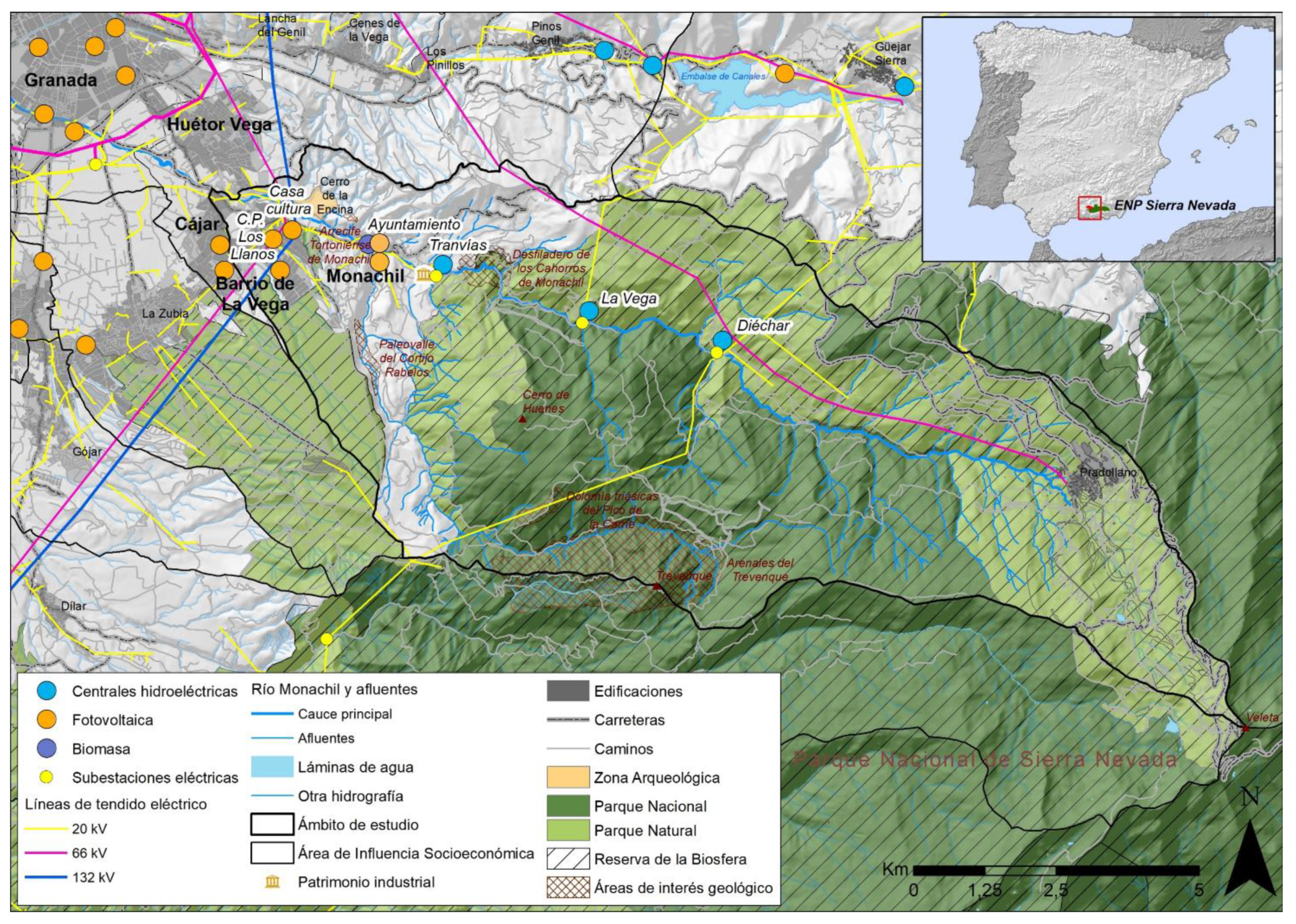
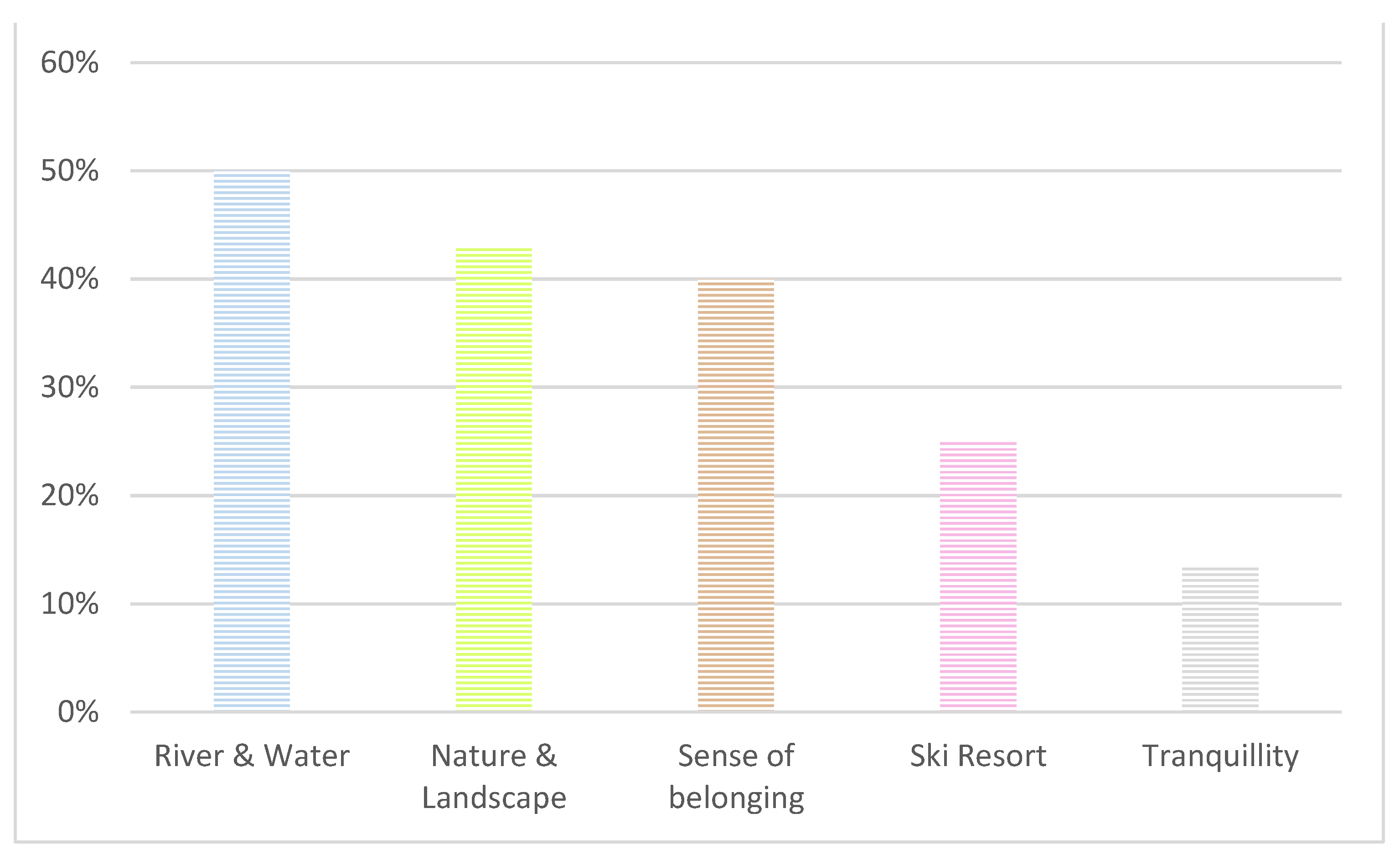
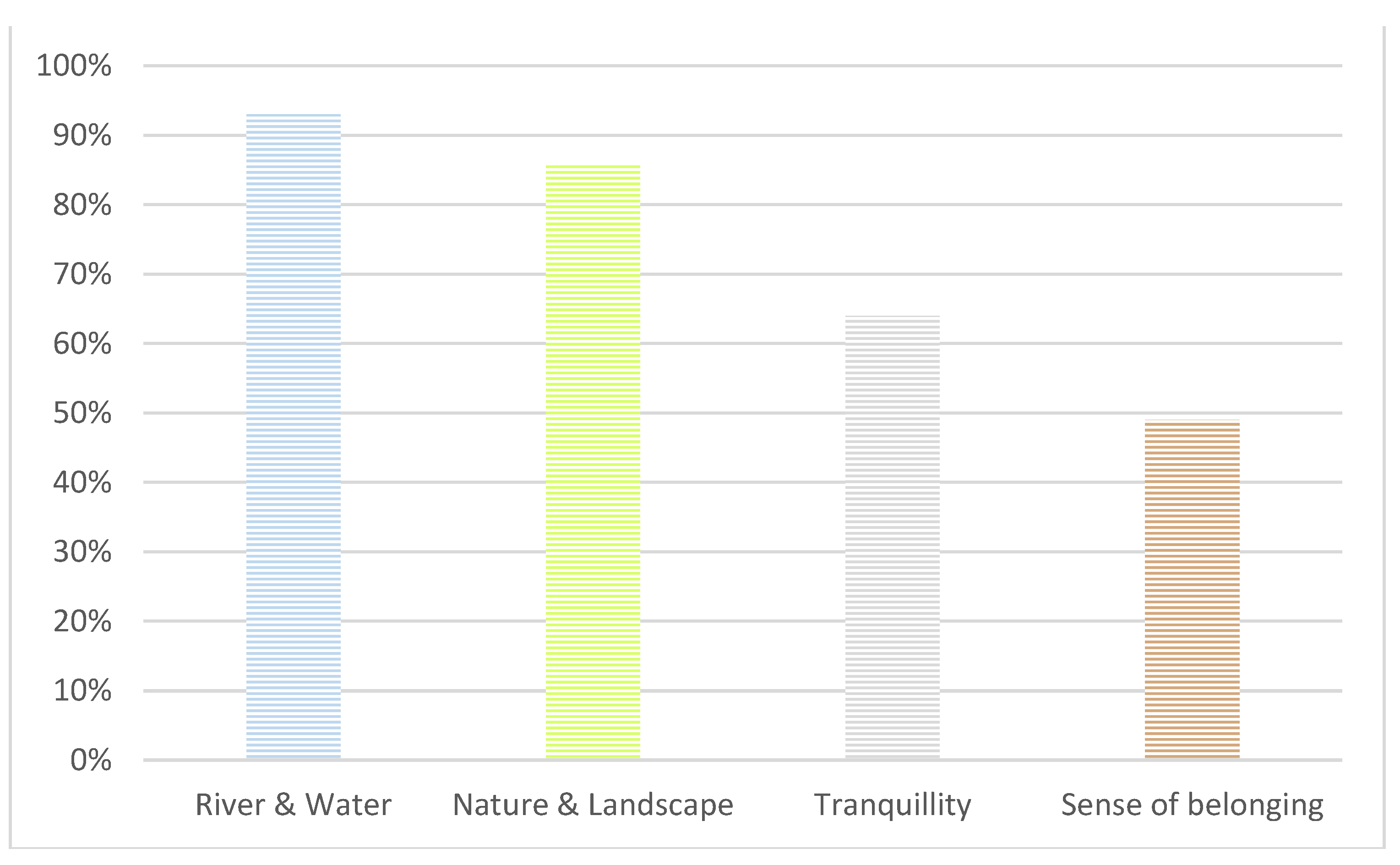
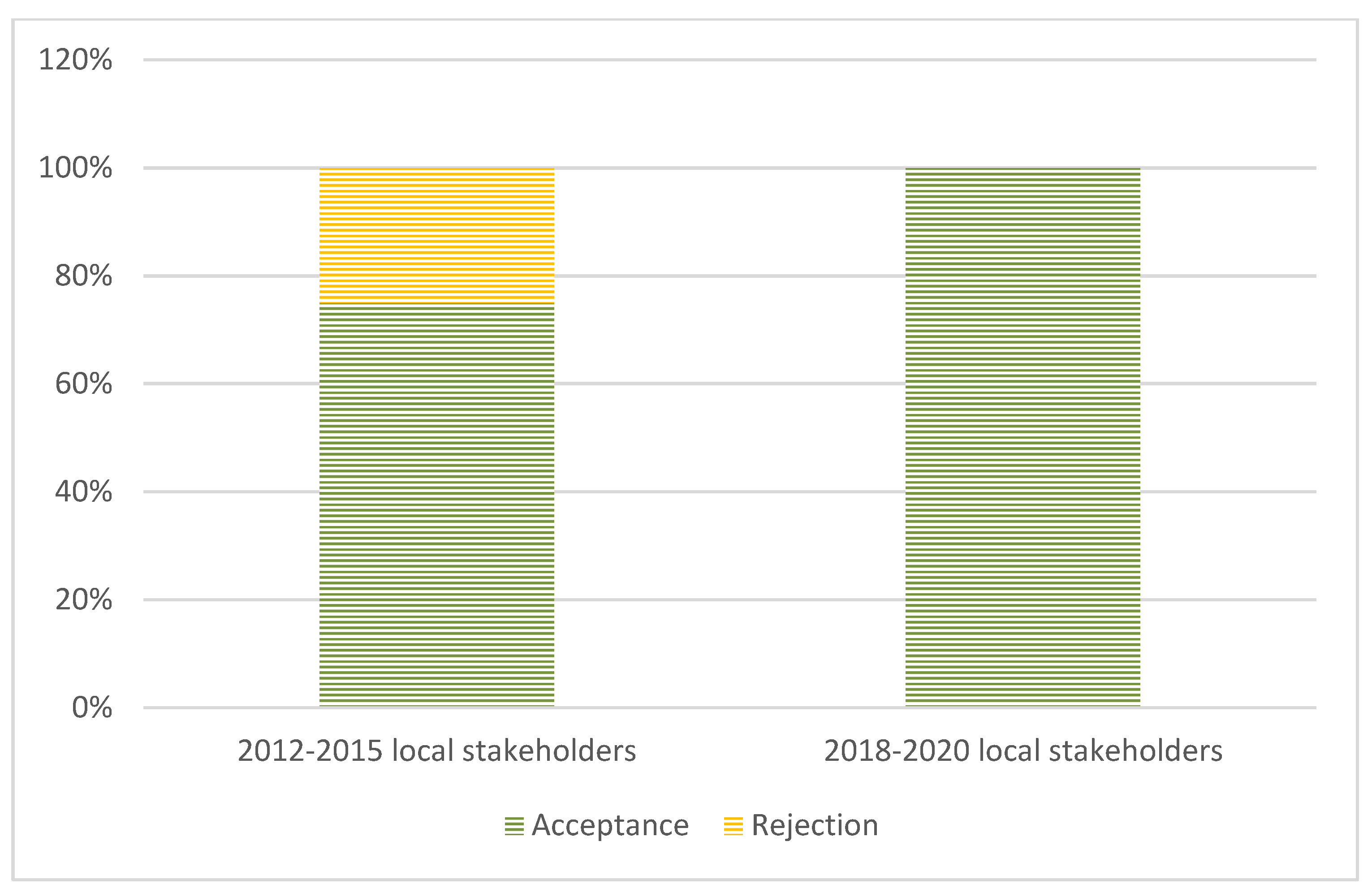
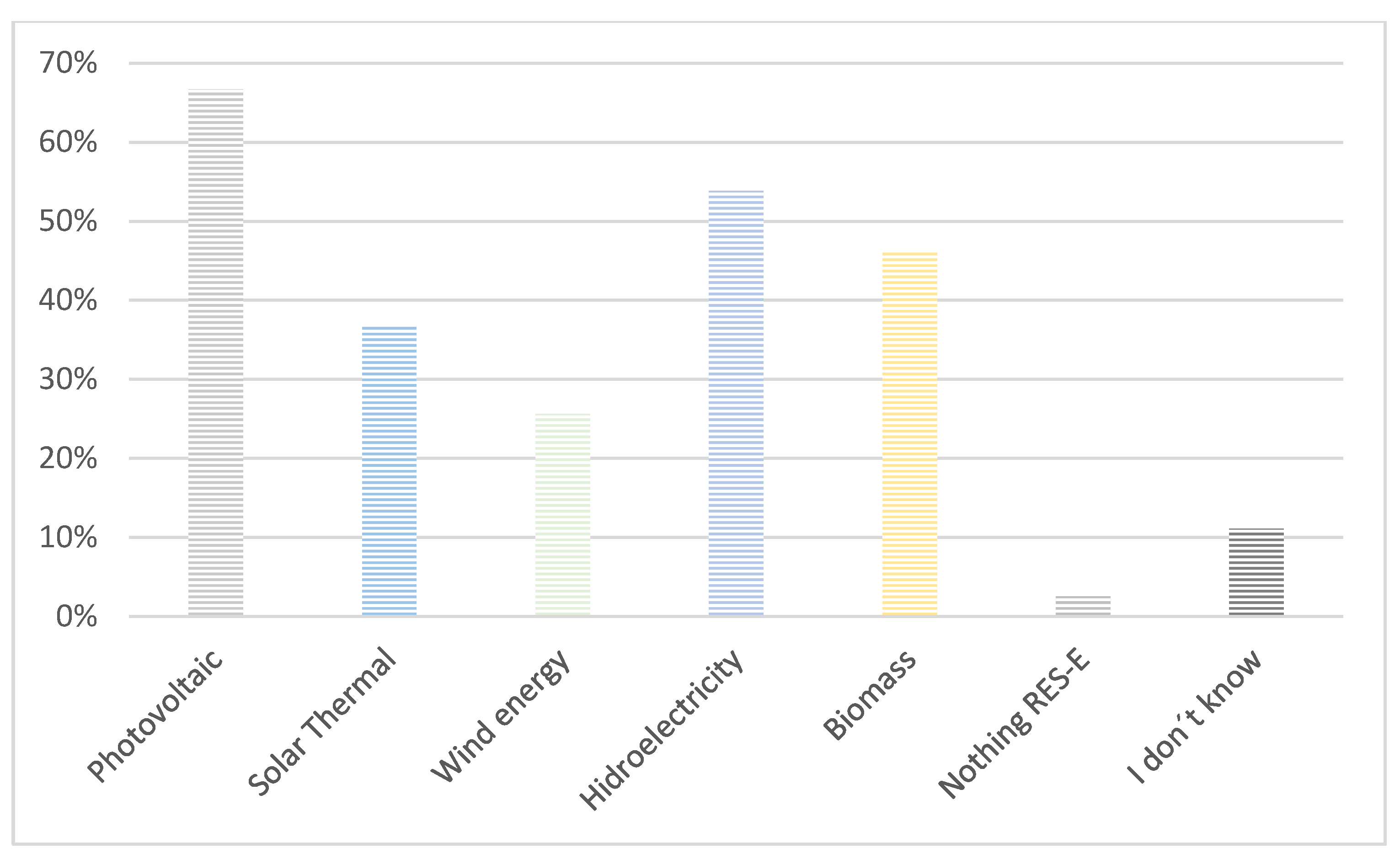
| Period | Context | |
|---|---|---|
| Hydroelectricity <5 MW | Late 19th century | Favourable topography. Available water resources. Small power plants—lighting nearby areas. |
| Hydroelectricity >5 MW | Mid-20th century | Emergence of alternating current—wide distribution area. Large plants reduce profitability, small plant closure. |
| Hydroelectricity and other renewable energies | 1970–2009 | 1970 oil crisis. Renewable energies self-sufficiency reduce dependence on foreign energy and environmental impact. Special Regime. Recovery of hydroelectric projects and development of renewable energies. |
| Water Framework Directive (WFD) | 2000 | Water is a heritage to be protected, defended, and treated as such. |
| European Landscape Convention (EPC) | Europe 2000 Spain 2008 | Cultural and natural heritage merge in an integral vision of the landscape that takes into account both natural and cultural aspects. Social dimension of landscape as an element of well-being. |
| Hydroelectricity and other RES-E | 2009–2015 | Stifle the development of the RES-E sector. Suspend economic incentives. Adopt fiscal measures that tax the generation and incorporation of energy into the electricity system. Elimination of the Special Regime. Charging for the use of inland waters. Same regulation for all installations that assume market obligations. |
| Hydroelectricity and other RES-E | 2019- Current | New impetus for the renewable energy sector, backed by favourable legislation, incentives, and an international framework of uncertainty, where energy prices continue to rise. Processes are streamlined and EIAs, and public participation are eliminated for large wind and photovoltaic projects. |
| 2012–2015 | 2018–2020 | ||
|---|---|---|---|
| Interviews | Interviews | Surveys | |
| Total | 20 | 10 | 118 |
| Designation | Installed Power | Waterfall Height | Operating Period | Owner | Recovery | Year of Recovery | State of Preservation |
|---|---|---|---|---|---|---|---|
| Old San Vicente Mill | 7.5 kW | 8 m | ? | Antonio Jaldo Serrano | No | Disappeared | |
| C.H. Sierra Nevada | 20 kW | 4.3 m | ? | Eléctrica de Sierra Nevada | No | Disappeared | |
| C.H. La Estrella | 8 kW | 20 m | ? | Fernandez Amigos La Estrella | No | Disappeared | |
| C.H. La Trola I | 610 kW | 35 m | 1909 | Eléctrica La Concepción | No | Ruined building | |
| C.H. La Trola II | 6 kW | 11 m | ? | No | Ruined building | ||
| C.H. Tranvías | 1.900 kW | 186 m | 1907–1974 | TEGSA supply (tramway) | Monachil town hall Power 2400 kW | 1992 | In operation |
| C.H. La Vega | 2.200 kW | 187 m | 1904–1967 | 1894—Compañía General de Electricidad | Grupo Cuerva | 1988 | In operation |
| C.H. Diéchar | 900 kW | 160–173 m | 1919–1966 | Hidroeléctrica Santa Marta 800 MW | Sevillana Electricidad | 1989 | In operation |
| 21. Are There Local Roots/Memories/Identities Related to Renewable Energy Projects in Your Territory? | ||||
|---|---|---|---|---|
| Yes | No | I do not know | ||
| 1 | There are buildings/buildings and other objects related to renewable energy installations of historical/architectural interest (hydroelectric plants and dams, reservoirs, etc.). | 53% | 26.5% | 20.5% |
| 7 | Old projects are part of the local landscape | 52.1% | 12% | 35.9% |
| Area | Ecosystem Services | |||
|---|---|---|---|---|
| Main Values | Supply Services | Regulatory Services | Cultural Services | |
| Mountains | River and water Nature and landscape Tranquillity Sense of belonging | Water for irrigation and consumption Livestock products Agricultural products Forest products (harvesting) Forest products (timber) Medicinal products Minerals Hunting Energy | Climate regulation Pollination Habitat for species conservation Air quality Soil fertility Erosion control Water regulation | Aesthetic value Sense of belonging Rural and nature tourism Education and scientific knowledge Cultural traditions Traditional ecological knowledge Quality landscapes Peace and quiet |
| Valleys | Nature and landscape River and water Tranquillity Sense of belonging | Agricultural products Livestock products Energy Water for irrigation and consumption | Soil fertility Pollination Climate regulation Habitat for species conservation Air quality Erosion control Water regulation | Traditional ecological knowledge Aesthetic value Sense of belonging Education and scientific knowledge Cultural traditions Quality landscape Peace and quiet |
| Renewable Energy Resources | Current Projects | Future Projects |
|---|---|---|
| Hydroelectricity | Accepted by the population, they are part of the local identity. | Problems due to pressure on water. Impact on ecosystems and landscape. Competition with other economic activities, such as agriculture or tourism. |
| Wind energy | None. | Impact on the landscape, biodiversity, values of the municipality, and territorial identity. Interference with tourism. |
| Solar energy | There are projects in detached houses, companies, and industries. There are projects in municipal buildings and projects for shared self-consumption of energy. | Compatible in industrial areas or areas of new growth. Compatible as self-consumption installations on roofs. Interference with landscape, agriculture, and tourism. |
| Biomass | Use in isolated dwellings Biomass boiler in the main building of the Town Hall. | Potential use of pruning waste. Impact on ecosystems. Possible interference with other economic activities. |
Publisher’s Note: MDPI stays neutral with regard to jurisdictional claims in published maps and institutional affiliations. |
© 2022 by the authors. Licensee MDPI, Basel, Switzerland. This article is an open access article distributed under the terms and conditions of the Creative Commons Attribution (CC BY) license (https://creativecommons.org/licenses/by/4.0/).
Share and Cite
Pérez, B.P.; Díaz-Cuevas, P. Connections between Water, Energy and Landscape: The Social Acceptance in the Monachil River Valley (South of Spain). Land 2022, 11, 1203. https://doi.org/10.3390/land11081203
Pérez BP, Díaz-Cuevas P. Connections between Water, Energy and Landscape: The Social Acceptance in the Monachil River Valley (South of Spain). Land. 2022; 11(8):1203. https://doi.org/10.3390/land11081203
Chicago/Turabian StylePérez, Belén Pérez, and Pilar Díaz-Cuevas. 2022. "Connections between Water, Energy and Landscape: The Social Acceptance in the Monachil River Valley (South of Spain)" Land 11, no. 8: 1203. https://doi.org/10.3390/land11081203
APA StylePérez, B. P., & Díaz-Cuevas, P. (2022). Connections between Water, Energy and Landscape: The Social Acceptance in the Monachil River Valley (South of Spain). Land, 11(8), 1203. https://doi.org/10.3390/land11081203





